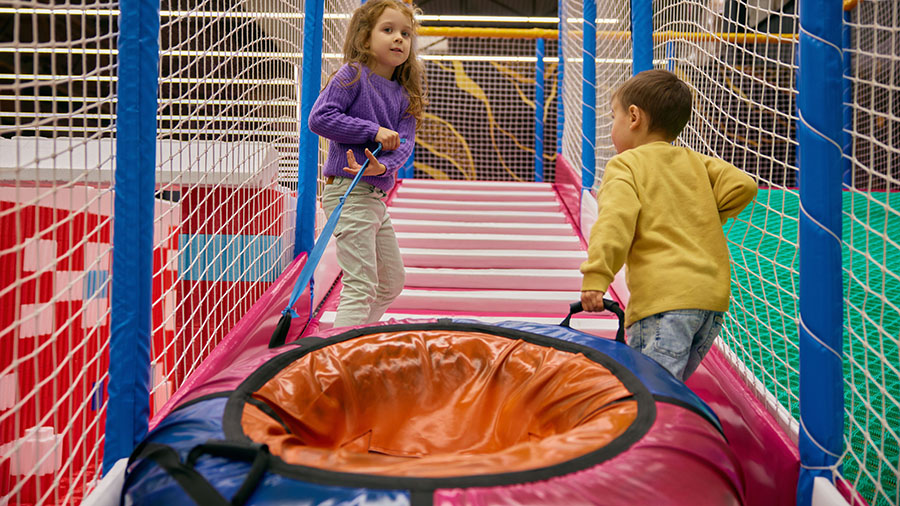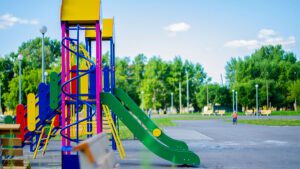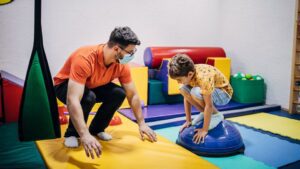In a digital world buzzing with screens and sedentary entertainment, indoor playgrounds have emerged as vibrant alternatives that encourage active play, social interaction, and creative exploration. Far from simply being a rainy‐day option, modern indoor play centers are thoughtfully designed to support physical, cognitive, and emotional growth in children. At the same time, they represent a lucrative opportunity for entrepreneurs who want to build a profitable, community‐focused business.
This comprehensive guide explores Why Indoor Playgrounds Matter and breaks down the myriad benefits for kids and businesses alike. We’ll define what an indoor playground is, delve into the developmental advantages for children, examine revenue opportunities for owners, detail popular equipment types, and offer practical advice on getting started. Whether you’re a parent seeking a safe play space for your child or an aspiring business owner researching your next venture, read on to discover how indoor playgrounds can make a lasting impact.
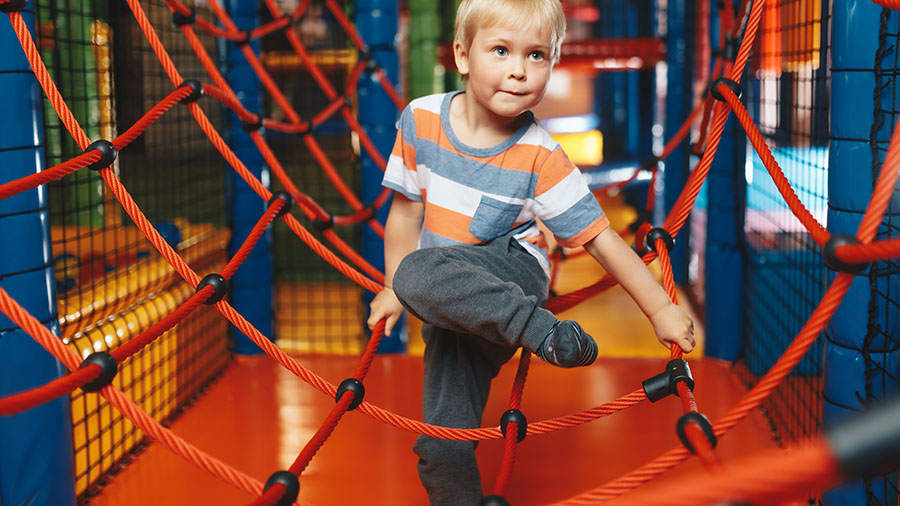
What Is an Indoor Playground?
An indoor playground (also called an indoor play center or soft play zone) is a climate‐controlled, enclosed facility designed specifically for children’s play. Unlike outdoor playgrounds—vulnerable to weather, maintenance issues, and safety hazards—indoor playgrounds operate year‐round and offer a self‐contained environment with padded flooring, netted structures, and safety‐tested play equipment.
Typical features of an indoor playground include:
- Slides & Tunnels: Short, medium, and long‐tube slides for toddlers to older kids
- Ball Pits: Shallow (toddler) and deep (school‐age) pits filled with plastic balls
- Climbing Structures: Soft or plastic walls, rope ladders, and rock‐climbing facades
- Obstacle Courses: Crawl tubes, balance beams, foam pits, and tunnel mazes
- Trampoline Zones: Mini trampolines and foam landing pads
- Interactive Panels: Sensory boards, sound walls, and educational play stations
- Toddler Areas: Cushioned blocks, low slides, and soft sensory toys
Because these facilities are indoor, they are open regardless of rain, snow, or sweltering heat, offering families and caregivers a predictable, safe place for children to burn energy, socialize, and explore. Modern centers often feature a café or seating area for parents, birthday party rooms, and organized programs—turning the venue into more than “just a playplace,” but a community hub for families.
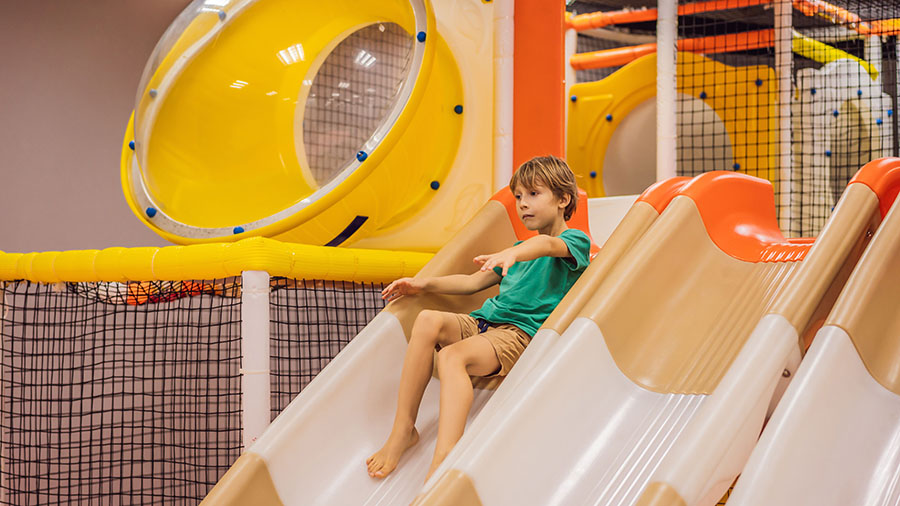
Benefits of Indoor Playgrounds for Kids
Indoor playgrounds provide far more than just a place to “run around.” Below are the key advantages they offer young minds and bodies.
1. Promotes Physical Fitness and Motor Skills
- Active Exercise: Many children today log hours on tablets, smartphones, or video games. Indoor playgrounds counteract this sedentary trend by providing a fun environment that motivates kids to climb, jump, and run—all activities that build cardiovascular health and muscle strength.
- Gross Motor Development: Navigating slides, climbing structures, and obstacle courses challenges children’s coordination, balance, and large‐muscle groups. Over time, kids develop confidence in their bodily movements, improving activities like running, jumping, and throwing.
- Fine Motor Development: Elements such as steering steering wheels, pushing levers, and manipulating interactive panels build smaller muscle control in the hands and fingers. These fine motor skills translate into better handwriting, improved dexterity, and easier performance of daily tasks.
Tip for Parents: Encourage your child to explore different sections—climbing walls for strength, ball pits for coordination, and sensory panels for fine motor practice. A well‐rounded session can address multiple facets of physical development.
2. Boosts Cognitive and Problem‐Solving Skills
- Spatial Awareness & Reasoning: Crawling through tunnels, maneuvering around obstacles, and finding the safest path down a slide stimulates spatial reasoning. As kids plan their routes, they practice problem-solving and decision-making.
- Cause & Effect Learning: Many indoor playgrounds include interactive elements—buttons that trigger sounds, levers that activate moving parts, or puzzle walls that light up. Children learn that one action leads to a reaction, reinforcing logical thinking.
- Imaginative Play: Themed areas (e.g., castles, pirates, or jungle adventures) encourage role-playing. When a child pretends one tunnel is a dragon’s cave or a slide is a waterfall, they strengthen creativity, language skills, and storytelling abilities.
Insight: According to early childhood education research, integrating physical activity with cognitive tasks accelerates brain development, especially in the prefrontal cortex—responsible for executive functions like planning, attention, and impulse control.
3. Fosters Social & Emotional Development
- Teamwork & Cooperation: Many obstacle courses and group activities require communication, turn-taking, and collaborative problem-solving. When two children navigate a balance beam together, they learn about trust, patience, and listening.
- Conflict Resolution: Inevitably, children may disagree over who goes next on a swing or whose turn it is in the ball pit. These moments offer opportunities for guided conflict resolution—teaching kids to negotiate, share, and apologize.
- Confidence & Self‐Esteem: Conquering a challenging climbing wall, sliding down a tall slide, or completing an obstacle course gives children a sense of achievement. These small successes help children build resilience, self-esteem, and a “can‐do” attitude.
- Emotional Regulation: Physical play releases endorphins and reduces stress, making it easier for kids to calm down after high‐energy activities. The dynamic environment also teaches children how to cope with excitement, impatience, and overcoming fear.
Pro Tip: Caring staff or “play guides” can facilitate positive interactions by modeling sharing, encouraging noisy play in a non‐disruptive manner, and praising cooperation.
4. Offers a Safe, Controlled Environment
- Weatherproof Play: Rain, wind, or sweltering heat no longer dictate whether children can get their daily exercise or engage in imaginative play. Parents and caregivers can plan visits without worrying about sunburn, muddy clothes, or icy slides.
- Certified Safety Standards: Reputable indoor playgrounds adhere to ASTM and CPSC guidelines—maintaining correct padding, soft‐fall surfacing, and secure netting. Staff are typically trained in first‐aid and CPR for immediate response should an injury occur.
- Cleanliness & Hygiene: Many centers enforce shoe removal, hand‐washing stations, and regular sanitizing protocols—important features in reducing the spread of germs, particularly during flu season or amid concerns about contagious illnesses.
Safety Check: Always confirm that the indoor playground you choose follows a strict maintenance schedule—regularly inspecting equipment for wear‐and‐tear and ensuring soft surfaces remain undamaged.
5. Inclusive Play for All Abilities
- Adaptive Equipment: More indoor playgrounds now incorporate ADA‐compliant ramps, sensory rooms, and equipment designed for children with mobility challenges or sensory processing disorders. Items like wheelchair‐accessible swings, tactile panels, and low‐impact trambolines ensure every child can participate.
- Structured Programs: Some facilities offer “sensory hours” or “quiet play” times—reduced noise and dimmed lights that accommodate children on the autism spectrum or with sensory sensitivities.
- Family Bonding: The all‐inclusive environment encourages siblings of varying abilities to play side by side, strengthening family bonds and promoting empathy from a young age.
Recommendation: Before visiting, check a center’s website or call ahead to learn about accessibility features or specialized programs—for a truly stress‐free experience.
6. Year‐Round Entertainment & Weather Independence
- Consistent Active Play: Winter ice and summer heat no longer sideline kids. Indoor facilities remain open all year, giving children a reliable outlet for energy and play at any time.
- Scheduled Classes & Events: Most centers host daily or weekly classes—tumbling, gymnastics, or dance—providing structured activities beyond free play. Seasonal events (Halloween mazes, holiday parties) keep the experience fresh and engaging.
- Convenience for Parents: Busy caregivers appreciate one‐stop destinations that combine safe, climate‐controlled play with on‐site snacks, Wi‐Fi, and seating areas for supervising siblings or working remotely.
Extra Perk: Some indoor playgrounds partner with local schools to provide field trips, or offer drop‐off “play camps” during teacher in‐service days—expanding opportunities for children and convenience for parents.

Benefits of Indoor Playgrounds for Your Business
An indoor playground isn’t just a space where kids can burn off steam. For entrepreneurs, community leaders, and investors, these venues represent diverse revenue streams, strong branding potential, and a lasting community impact.
1. Recurring Customer Base & Steady Cash Flow
- High Repeat Visits: Families with young children often visit multiple times per week, especially in neighborhoods lacking safe outdoor play areas. The more diverse your offerings (e.g., open play, classes, camps), the greater the incentive to return.
- Membership & Season Passes: Offering discounted monthly or annual memberships locks in loyal customers. Parents value predictability—knowing they can bring their child anytime without per‐visit fees cements long‐term relationships.
- Birthday Party & Event Bookings: A top source of revenue. Families frequently rent private rooms or entire sections for celebrations. Birthday packages can include themed decorations, catering, and dedicated staff—boosting per‐event profit margins.
Revenue Tip: Diversify pricing—offer hourly rates for casual visits, multi‐visit bulk packages, and premium rates for party packages or special events.
2. Multiple Ancillary Revenue Streams
- Food & Beverage Concessions: Simple snack bars, coffee shops, or vending machines can significantly increase average ticket value. Healthy, kid‐friendly menus (fruit cups, smoothies, wraps) appeal to health‐conscious parents.
- Merchandise & Retail: Selling branded apparel, toys, reusable water bottles, or even educational books provides additional income. Parents often purchase small souvenirs to commemorate a fun outing.
- Classes & Workshops: Gymnastics, arts & crafts, music, and sensory play sessions—offered daily or weekly—command higher per‐participant fees. They also encourage repeat visits.
- Sponsored Zones & Partnerships: Collaborations with local businesses (preschools, pediatricians, children’s clothing stores) can provide advertising revenue. For instance, a local dentist might sponsor a “smile station” in exchange for promotional space.
How to Maximize: Regularly analyze which offerings generate the most revenue—snacks, classes, or merchandise—and expand those areas strategically.
3. Strong Branding & Word‐of‐Mouth Marketing
- Unique Theming & Experiences: A well‐designed, themed environment (space station, enchanted forest, pirate cove) becomes an Instagram‐worthy “must‐visit” destination. Parents share photos online, providing free marketing.
- Community Engagement: Hosting charity events, local sports team fundraisers, or parents’ meetups enhances local goodwill. A reputation for safe, clean, and engaging fun spreads through word of mouth rapidly.
- Positive Reviews & Online Presence: Satisfied families leave 5‐star reviews on Google, Facebook, and Yelp. Incorporating customer‐driven content (photos, videos, testimonials) on your website and social media boosts credibility and visibility in search results.
Pro Tip: Encourage customers to tag your location on social media; consider small incentives (e.g., 10% off next visit) for reviews or shared posts.
4. Scalability & Expansion Potential
- Proven Business Model: Once you refine your operations—staffing, pricing, cleaning protocols, and marketing—you can replicate the same successful format in new neighborhoods or cities.
- Franchising Opportunities: If your indoor playground becomes widely recognized, franchising can rapidly expand your footprint. Even a single flagship location can spawn multiple revenue streams through licensing arrangements.
- Seasonal Adaptability: Because these are indoor facilities, you can operate year‐round without seasonal dips. You can also launch “pop‐up” mini playgrounds in malls or high‐footfall areas during holiday seasons, expanding your brand reach.
Expansion Insight: Conduct local market research—identify areas with young demographics, limited existing play options, and strong retail clusters—to maximize franchise success.
5. Community Building & Social Impact
- Local Employment: Indoor playgrounds typically need staff for supervision, cleaning, food service, and administration—creating jobs in the community.
- Family‐Friendly Hub: Your facility becomes a gathering place for families—parents network, children make friends, and the venue may even support local charities or school fundraisers.
- Safety & Accessibility: By offering adaptive equipment and sensory programs, you make play inclusive—catering to children with particular needs and fostering a more equitable community environment.
Legacy Building: Many communities remember the first “big indoor fun center” fondly as “where we made our first friends.” You’re not just opening a business—you’re laying the foundation for cherished childhood memories.
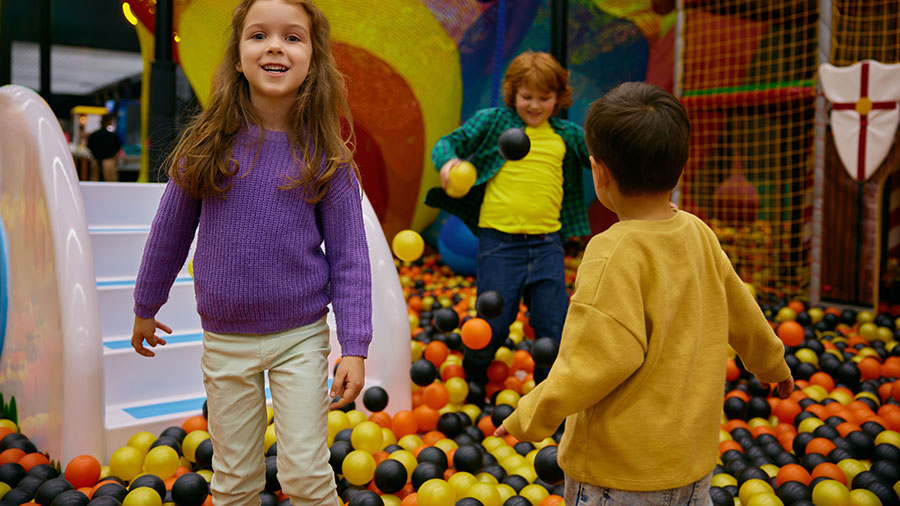
Popular Types of Indoor Playground Equipment
Below is a curated list of the most sought‐after indoor playground attractions. A well‐balanced mix caters to a wider age range and varied developmental needs.
- Slides & Tunnels
- Straight slides (short and medium lengths for toddlers)
- Spiral and enclosed “tube” slides for older kids
- Gentle baby slides for early walkers
- Climbing Structures
- Soft rock‐climbing walls with adjustable holds
- Rope ladders, cargo nets, and bridge walkways
- Monkey bars and multi‐level platforms
- Ball Pits & Foam Pits
- Shallow toddler ball pits (6–12 inches of balls)
- Deep adult‐height foam pits for safe jumps and flips
- Ball cannons or foam ball games for interactive fun
- Obstacle Courses & Ninja Warrior Zones
- Balance beams and foam stepping stones
- Hanging obstacles (rings, ropes, hoops)
- Climbing nets, crawl tubes, and vault boxes
- Trampoline & Jumping Areas
- Individual padded trampolines (with foam surrounds)
- Large interconnected trampoline arenas
- Slam dunk zones or basketball hoops over trampolines
- Interactive Play Panels
- Sensory panels (textured boards, mirrors, bead mazes)
- Musical panels (drums, xylophones, sound tubes)
- Puzzles and magnetic boards for cooperative play
- Soft Play Areas & Toddler Zones
- Foam blocks, shapes, and tunnels for early exploration
- Cushioned floors and small‐scale structures
- Quiet corners with books or sensory toys for downtime
- Role‐Play & Imaginative Areas
- Mini grocery stores, kitchens, or cafes
- Dress‐up corners with costumes and props
- Puppet theaters and storytelling nooks
- Toddler‐Friendly Swings & Rockers
- Bucket‐seat swings with safety harnesses
- Gentle glider or pea‐pod swings for sensory integration
- Spring riders (animals, cars, boats) mounted on foam bases
- Interactive Floors & Walls
- Projected games (puzzles on the floor, interactive hopscotch)
- Motion‐sensing games (shadow tag, virtual ball games)
- LED walls or floors that respond to movement
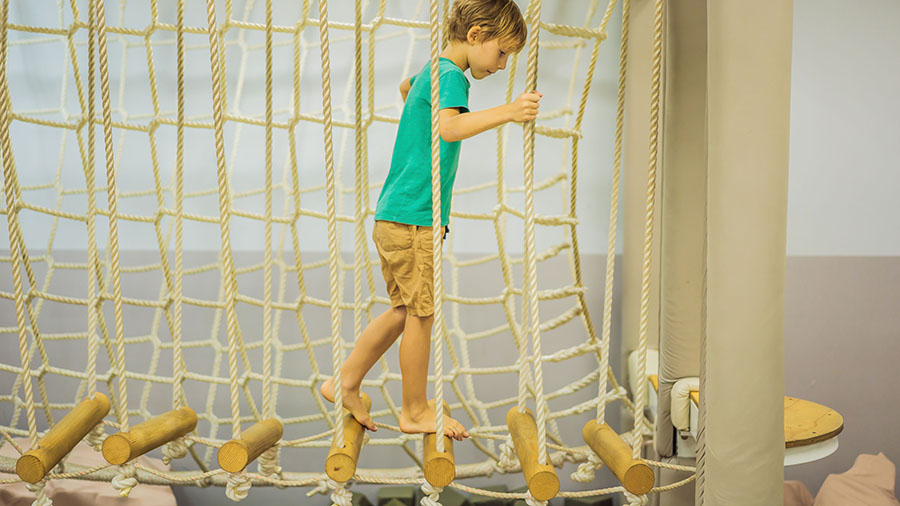
How to Launch an Indoor Playground Business
1. Conduct Market Research & Feasibility
- Demographic Analysis: Identify neighborhoods or suburbs with a high concentration of families—data on average child age can guide equipment selection (toddlers vs. school‐age).
- Competition Review: Visiting existing indoor playgrounds reveals service gaps—perhaps a lack of sensory‐friendly hours, a café with healthy snacks, or after‐school programs.
- Pricing & Demand: Survey parents about acceptable price points for hourly play, membership plans, and party packages. Run a small focus group to gauge interest in additional offerings like classes, merchandise, and hosting events.
Tip: Use online tools (Google Trends, Facebook Ads Audience Insights) to estimate local interest and seasonal peaks.
2. Secure a Location & Layout Design
- Space Requirements: Aim for at least 5,000–7,000 square feet for a moderate‐size facility. This allows room for distinct zones (toddler, school‐age, café, party rooms).
- Zoning & Permits: Check local regulations—some municipalities require special use permits or compliance with building codes (fire exits, ADA accessibility, maximum occupancy).
- Floor Plan Development: Work with a specialized designer (like ParknPlay Design) to create a layout that optimizes visibility, supervises higher‐risk areas, and ensures smooth traffic flow. Incorporate:
- Entrance & Reception: Clear signage, check‐in kiosks, queue management
- Toddler Zone: Close to the entrance for parental supervision, with low‐risk soft play
- Main Play Area: Obstacle courses, slides, trampolines in the center, visible from multiple angles
- Café / Seating Area: Overlooking the play area, with direct sight lines to parents
- Party / Multi‐Purpose Rooms: Private rooms for birthdays and special events, soundproofed for noise control
- Restrooms & Changing Stations: Conveniently located near all zones, with child‐size toilets and sink step stools
3. Choose Reliable Equipment & Safety Partners
- Safety‐Certified Manufacturers: Partner with companies that meet ASTM F1918‐compliant standards for commercial indoor playground equipment.
- Quality & Durability: Seek materials that withstand heavy use—reinforced steel frames, tear‐resistant vinyl, and non‐toxic, flame‐retardant foam.
- Installation & Maintenance Services: Consider turnkey solutions where the supplier provides installation, routine safety inspections, and replacement parts.
Pro Tip: Request sample reports on safety audits and read customer testimonials on durability and post‐sale support.
4. Staffing, Training & Operations
- Staffing Levels: Aim for a ratio of 1 staff member per 10–15 children, adjusting for age group and risk level (e.g., more supervision near trampolines).
- Training Programs: Staff should be CPR/First Aid certified and trained in crowd management, de‐escalation, equipment maintenance, and sanitation protocols (especially post‐COVID).
- Standard Operating Procedures (SOPs): Develop clear SOPs for:
- Equipment Inspections: Daily walkthrough checklists, weekly deep inspection logs
- Cleaning & Sanitizing: Scheduled cleaning of high‐touch surfaces, ball pits, and Café areas
- Emergency Response: Fire drills, evacuation routes, first‐aid emergency drills
- Customer Service: Check‐in/out process, membership verification, conflict resolution protocols
5. Marketing & Grand Opening
- Pre‐Launch Campaign: Generate buzz through social media (Facebook and Instagram ads targeting parents), local press releases, and partnerships with preschools or family bloggers who can review the facility.
- Grand Opening Event: Offer free or discounted “soft launch” sessions for local influencers, parenting groups, and local press. Provide a unique experience—face painting, balloon animals, or a ribbon‐cutting ceremony with a local celebrity or mayor.
- Ongoing Engagement: Host weekly themed days (Toddler Tuesday, Parent Workout Wednesday, Family Fun Friday) and monthly events (Holiday Parties, Back‐to‐School Kickoff) to draw repeat visits.
Marketing USP: Emphasize convenience (weatherproof, clean, safe), variety (toddler to tween zones), and extras (Café menu, sensory hours, birthday packages).

Best Practices for Operating & Growing Your Indoor Playground
1. Keep Equipment Fresh & Engaging
- Rotate or Refresh Attraction Zones: Every 6–12 months, introduce new elements (e.g., a new obstacle segment or interactive LED wall) to keep regulars excited.
- Host Seasonal or Themed Events: Halloween haunted‐house-style obstacle courses, winter “snowball” foam pit events, or summer science fair days with STEM activities.
2. Prioritize Cleanliness & Safety
- Regular Deep Cleaning: Weekly deep‐clean cycles of ball pits, carpets, and upholstery
- Sanitation Stations: Hand sanitizer dispensers at every entrance, snack area, and high‐traffic zone
- Safety Audits: Quarterly third‐party inspections that verify compliance with ASTM and local fire/health codes
3. Maximize Revenue Streams
- Diverse Pricing Models: Single‐visit tickets, family passes, membership tiers with perks (free birthday room rental, discounted café items)
- Birthday Party Packages: Tiered options (basic party room + playtime; deluxe including cake, decorations, and goody bags)
- Group & Corporate Events: Adapt to host youth sports teams, scout troops, or corporate “family days” to fill slower weekday slots
4. Leverage Technology & Data
- Integrated Booking & POS System: A cloud‐based platform where parents can book passes, parties, classes, and purchase merchandise online
- Data‐Driven Decisions: Track peak hours, most popular attractions, and customer feedback to optimize staffing, promotions, and facility layout
- Interactive Apps: Consider a custom branded mobile app that provides real‐time updates on facility crowd levels, promotions, and loyalty points.
5. Cultivate Community & Partnerships
- Local Sponsorships & CoBranding: Partner with pediatric clinics, daycares, and children’s bookstores for cross‐promotions—discounted playtime with purchase or joint events
- Charitable Initiatives: Host “pay it forward” play days where a portion of proceeds supports local children’s charities or underprivileged youth sports programs
- School & Daycare Field Trips: Negotiate special rates for group field trips—an excellent way to introduce new families and build long‐term relationships.

Frequently Asked Questions (FAQs)
1. What age range do indoor playgrounds serve?
Most indoor playgrounds have dedicated zones for different age groups—toddler areas (0–4 years) with low slides and soft blocks, school‐age sections (5–12 years) featuring obstacle courses and trampolines, and sometimes teen/adult exercise classes in separate fitness zones.
2. How much space is required to start an indoor playground?
A medium‐sized facility typically ranges from 5,000 to 10,000 square feet. A 5,000 sq. ft. footprint can support a toddler area, a main play structure, a small trampoline zone, a café, and party rooms. Larger venues (8,000–12,000 sq. ft.) allow for multiple full‐size attraction zones and expanded amenities.
3. Is running an indoor playground profitable?
Yes—when executed well. Successful indoor playgrounds often achieve 50–70% gross margins on admissions, with additional revenue from birthday parties, concessions, merchandise, and classes. Profitability depends on efficient operations, strategic pricing, and strong community engagement.
4. What safety measures are essential?
- Certified Play Equipment: ASTM‐compliant, impact‐absorbing flooring, secure netting, and regularly inspected structures.
- Trained Staff: CPR/First Aid certification, crowd control training, and clear SOPs.
- Sanitary Protocols: Daily cleaning, hand sanitizers at all entrances, and periodic deep sanitization (ball pits, upholstery).
- Emergency Preparedness: Fire drills, clear evacuation routes, and well‐marked exits.
5. How do I maintain mulch or surfacing?
If your indoor playground includes a foam pit, replace foam cubes every 6–12 months. For padded flooring, perform daily walk‐throughs to spot tears, weekly vacuuming of carpeted areas, and quarterly professional deep‐cleaning to remove trapped dust. For hybrid indoor/outdoor centers, ensure playground mulch (wood or rubber) is raked and topped up every 3–6 months, maintaining at least 9–12 inches of depth.
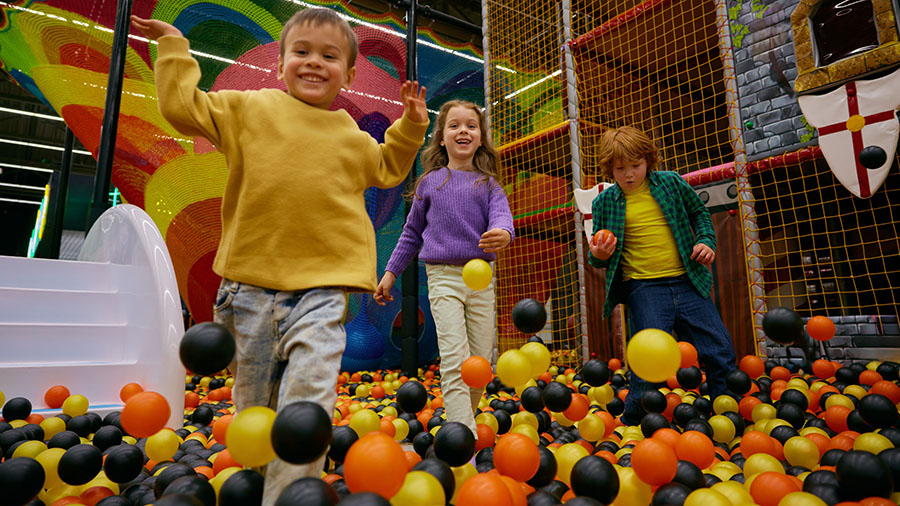
Conclusion
Indoor playgrounds have revolutionized how children play and how entrepreneurs build family‐centric businesses. By providing a safe, climate‐controlled environment, these facilities promote physical fitness, cognitive development, and social well‐being in children. Parents benefit from a dependable venue where kids can burn energy and form social bonds, while business owners gain multiple revenue streams, branding opportunities, and a chance to become local community hubs.
From cost‐effective safety surfacing to engaging obstacle courses, investing in an indoor playground means investing in children’s futures and community vitality. If you’re a parent, embrace the boundless benefits—let your child’s imagination run wild and watch them develop holistically. If you’re an entrepreneur, capitalize on a proven business model that marries fun and profitability.
Ready to take the next step? Connect with industry experts like SPIKE to explore custom equipment solutions, space planning, and turnkey installation services. Whether you’re aiming to build your first indoor play center or expand an existing facility, our comprehensive guidance ensures your venture thrives.
Visit SPIKE today to learn more and start building a dynamic, thriving indoor playground that will delight children—and reward your entrepreneurial aspirations—for years to come.
